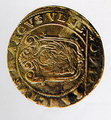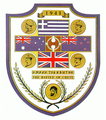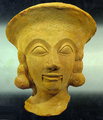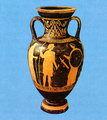Museums in Crete
Opening hours for all museums unless stated otherwise:
All year: Daily: 08.30 - 15.00, Monday: closed

CHANIA
The new Archaeological Museum of Chania is housed in the Venetian church of San Francesco. Its exhibits from western Crete and other areas date from the Neolithic to the Roman era, and include idols, statues, inscriptions, weapons, pottery, sealstones, coins, jewellery, etc.

Three-handled amphora (1420-1400 BC)
Tel. No.: 28210-90 334 Fax: 28210-94 487
The Historical Archives of Crete include a rich collection of folklore and material related to the history of the island. The archives are among the largest in the country, second only to General Archives of the Greek State. Open daily 8:00-13:00, except weekends and public holidays. Tel. No: 0821-22 606.
The Nautical Museum of Chania is located on the mole of the Venetian harbor.
The Museum was inaugurated on the 27th May 1973, date of the 32nd anniversaryof the Battle of Crete. It includes models of ships, various nautical instruments and objects such as range finders, barometers, wind-gauges, course and speed abaci, torpedo firing computer, magnetic boat compasses, meteorogical instruments, sextants, a planisphere, torpedo-boat steering gear, etc. There are also paintings, portaits, authentic historic photographs, such as the raising of the flag of the Union of Crete with Greece in the Firka fortress at Chania, on the 1st December 1913, etc. Also exhibited are relics such as uniforms and other memorabilia which belonged to the heroic dead of the Greek Navy, guns which had been used in the war of 1912-13, etc. All the exhibits from the naval tradition of Greece are classified according to their historical periods, that is:Bronze age-Classical and Hellenistic (2800 BC-6th century AD). Venetian period (1200 AD to the 17th century), Byzantine and post-Byzantine period (650 AD to the 18th century), the period of the Ottoman rule-the struggles for Independence (1650-1909), the Balkan Wars (1912-1913), World War II (1940-1944), the post-War period (after 1944).The museum is open 10:00-14:00, every day except Monday. From October to end of May, is open also 16:00-18:00, on Tuesday, Thursday and Saturdays and 17:00-19:00 during the other months. Address: Akti Koundourioti, 731 36 Chania, Crete Tel. No.: 28210-26 437 Fax: (+30-28210) 27936

Historical and Folk Art Museum of Gavalohori. The Museum was founded in 1967 and was inaugurated in September 1993. It is housed in a building which is a characteristic example of local traditional architecture and stands on two levels. There is a ground floor with a verandah, an inside courtyard, an arched house proper, with its utility areas and a first floor with an "odas" or large room. Part of the building was built during the venetian occupation, while the first floor was built during the Ottoman rule. The building served as a private home until the end of the 19th century and was donated to the community of Gavalohori by George and Maria Stylianaki. The objects in it are displayed according to modern miseological concepts, with explanatory texts, photographs, drawings and models, and new exhibits are added each year. The Museum is divided into seven room, according to the following units: The Arched House, Silk, Pottery, Lace-making, Masonary and Stone carving, Church and Woodcarving. In the historical section of the Museum are exhibited guns and swords from the lengthy struggles of the Cretans for their freedom; also a small part of the collection of paintings and historical lithographs in which are depicted same of the most significant events of the history of Greece and Crete, coins (Roman, Byzantine, Venetian, Turkish, coins of the Cretan State and Syracusan coins from the period (405-345 BC). Also medals won on the fields of battle by the citizens of Gavalohori.
Address: village of Gavalohori Apokoronou, Chania
Tel.: +30-28250 22625
RETHIMNON

The Archaeological Museum of Rethimnon is housed in the Venetian Loggia. Among the exhibits of the museum. there are interesting archaeological finds from the region, as well as a fine coin collection. The museum contains the following collections: Late Neolithic (3500-2900 B.C.) and Early Minoan (2800-2100 B.C.) finds from the caves Gerani, Melidoni, Margeles and Helenes finds from the buildings at Apodoulou, Monastiraki and the peak sanctuary at Vrysinas, dated to the Middle Minoan period (2100-1600 B.C.) Late Minoan finds (1600-1100 B.C.) from the cemeteries, the most representative being that of Armenoi finds of the Geometric (1000-700 B.C.) and Archaic (700-500 B.C.) periods from Eleutherna and Axos finds from Stavromenos and Argyroupolis (ancient Lappa) dated to the Classical, Hellenistic and Roman periods.
Tel.: 28310-54668.
The L. Kanakakis Gallery - Centre for Contemporary Art - was founded in 1992 by the Borough of Rethimnon. It houses a collection of approximately 200 pieces of modern Greek art, including around 70 painting by Lefteris Kanakakis, the Rethimno painter. In 1995 the gallery and the town of Rethimnon became part of the National Cultural Network set up to promote contemporary visual arts within an international framework.
Address: 5 Xanthoudidou Street 74 100 Rethimnon
Tel +30 28310 52530 52689
Fax +30 28310 52689
email rca@ret.forthnet.gr
HERAKLION

The Archaeological Museum of Heraklion is one of the most important museums in Greece. Here are assembled almost all the finds from the Minoan era. Pottery, stone carvings, sealstones, statuettes, gold, metalwork, the marvelous frescoes from the Royal and Little Palaces and villas of the wealthy, and finally, the unique painted limestone sarcophagus from the Agia Trias. It houses the most important and representative finds of the Minoan civilization. The foundation of the first museum (1904-1912) is owed to the efforts of two Cretan archaeologists, Joseph Chatzidakis and Stephanos Xanthoudides, Ephors of the Archaeological Service. It housed the valuable finds from Crete until 1937, when the construction of the modern, antiseismic building was begun. Thanks to the efforts of Prof. Nicolaos Platon, the treasures of the museum survived during World War II, although the building was seriously damaged.
Address: 1, Xanthoudidou str. Heraklion
Opening hours: From November 1st to February 29: Daily: 08:00 - 17:00, Monday: 12:00 - 17:00 From March 1st to October 31 : Monday: 12.00 -19.00 Tuesday - Sunday and Holidays 08:00 - 19:00
Tel. No.: 2810-22 60 92, or 22 46 30. Fax: +30-2810-241515

In the Historical Museum of Heraklion, exhibits from the Byzantine, Venetian and Turkish periods and historical documents of the more recent Cretan history are shown. Except these, a rich collection of folk art consisting of local costumes, textiles, wood carving and embroidery are exhibited here, as well as a representation of a tradition Cretan house. The Museum was founded in 1953 and includes the following collections of exhibits: 1. Byzantine-Mediaeval collection, Byzantine, Venetian and Turkish sculptures and inscriptions, wall paintings (13th-16th cent.), sacred vessels and vestments, coins, jewellery and miniature work of the Byzantine and Venetian period. Also the only existing painting in Crete by Domenicos Theotokopoulos (El Greco) entitled "View of Mount Sinai and the Monastery". 2.Historical Collection: Relics of the Cretan revolutions of the 19th century and of the Cretan State (1898-1913). Flags, arms, portaits of heroes of the patriotic struggles, jewellery, engravings, furniture, costumes, maps, memontoes. Also historic documents and a collection of photographs. 3. Folk art collection: Hundreds of representative samples of Cretan folk art(women and embroidered articles, Lace, costimes, jewellery, miniature work, musical instruments etc). Reproduction of the interior of an old Cretan rule house. 4. Nikos Kazantzakis Room: the desk, library, personal mementoes and manuscripts of many of the works of the great writer. 5. Tsouderos Room: the desk, library and personal mementoes of the Prime Minister of the Battle of Grete, engravings, maps, rare editions and a collection of Cretan postage stamps.
Address: Lyssimachou Kalokairinou str., 71202 Heraklion
Opening hours: Summer period: Every day: 9.00 - 17.00 , Saturdays: 9.00 - 14.00, Sundays - Holidays: closed.
Tel. No.: 2810-288708, 081-28 32 19. Fax: 2810 - 283754
EmailKAZANTZAKIS MUSEUM. The Kazantzakis Museum is situated at Varvaroi, approximately 20 km. to the south of Heraklion. It was founded to preserve the work and to record the life of the Cretan writer. It includes some of the writer's personal belongings and those of his family, documents, letters, the first Greek editions of his books, and translations in 49 languages in 54 countries, photographs, busts, works of art, as well as documents referring to stagings of his theatrical works and of novels adapted for the theatre, photographs, posters, programmes, models of stage settings and costumes as they have been presented in performances all over the world. There is also radio and television material as well as a collection of press reviews which refer to Kazantzakis and have been published in Greek and foreign newspapers. Finally, there is an audiovisual presentation in five languages - Greek, French, English, German and Dutch to illustrate the development of this universal writer's life and career. ADDRESS: N.Kazantzakis Museum, Varvaroi (Myrtia), 701 00 Heraklion, Crete
Tel.: (2810) 742451, 741689
Collection of St Catherine of Sinai.The Monastery of St Catherine (Aghia Aikaterine), which is a metochi (dependency) of the monastery of the same name on Mount Sinai, was an important cultural and artistic centre from the 15th to the 17th century -the period between the fall of Contantinople and the capture of Chandax (Herakleion) by the Ottoman Turks (1669). The katholikon is preserved and now houses a collection of representative works of the Cretan renaissance, prominent amongst which are icons painted by Michael Damaskenos. The display also includes wall-paintings, manuscripts, religious vestments, liturgical vessels, and other treasures. There are the following collections: Collection of icons of the Cretan School. Collection of ecclesiastical books. Collection of vestments. Wall-painting fragments.
Tel.: +30-2810 - 288484, Fax +30-2810 - 242111

Municipal Museum of the Battle of Crete and the National Resistance. The Museum was created by the Municipality of Herakleion, following the organization of an exhibition of documents of the period 1941-1945, on the occasion of the celebration on the 50th anniversary of the Battle of Crete(1941). It is housed in a large room in a building in the centre of the town. Among the Museum's exhibits are thousands of authentic photographs, paintings and drawings of the Battle of Crete and the national resistance, about two hundred books, monographs, essays on the historic events from 1941 to 1945, hundreds of documents and a great many newspaper cuttings. The Museum also includes a variety of objects related to the war (arms, accessories, uniforms, items of everyday use etc.). In addition, the museum also operates as a research centre thanks to a team of researchers and scientists who have undertaken to collect archival material from ten countries, to translate war documents of the 1940-1945 period, as well as to write about the Battle of Crete.
Address: Doukos Beaufort and I. Chatzidaki, 715 00 Heraklion
Tel.: +30-2810 221227

The Natural History Museum of Crete (NHMC) offers the visitors a unique chance of a rich experience on the natural environment of Crete and its distinctiveness, as it reveals from the ecologically and culturally complex landscape of the Eastern Mediterranean. In suitably arranged exhibition area of 800 sq.m., with realistic models of biotopes, animal and plant collections, as well as plenty of photo material, the visitor discovers the natural beauty of Crete and continental Greece. Forests, phryganic and maquis vegetation, marshes, caves, rocky and sandy beaches, mountain massifs as well as special presentations on threatened animals (sea mammals, birds, etc), are some of the topics of the permanent exhibition.
Address: 157
Knossou Av., the road leading to the ancient palace of Knossos.
Opening hours: from Monday to Friday 9 am to 5 pm and Sunday
11 am to 7 pm.
Tel.: +30 2810 324 711
AGIOS NIKOLAOS

The Archaeological
Museum of Agios Nicholaos contains a rich collection of finds
from excavations in eastern Crete.
The Museum of Aghios Nikolaos was founded in 1970 in order to house
the numerous new archaeological finds from eastern Crete, which
until then, were housed in the Museum of Herakleion. Its collections
include:
• Finds from the Early Minoan (3000-2000 B.C.) cemetery at Aghia Photia of Sitia
• Finds from the Early Minoan II settlement at Fournou Koryfi of Myrtos
• Finds from the Early Minoan II-III (2600-2200 B.C.) cemetery on the islet of Mochlos Finds from Middle Minoan (2000-1550 B.C.) peak sanctuaries: Petsophas, Modi, Traostalos, Kalamaki, Prinias, Etiani, Kephala
• Finds from the Late Minoan III (1400-1200 B.C.) tombs of Milatos and Kritsa
• Finds from the Geometric deposit at Anavlochos Vrachasiou.
• Finds from the Daidalic deposit at Seteia (beginning of 7th century B.C.)
• Finds from the Archaic deposit at Olous (end of 7th-6th centuries B.C.)
• Finds from Lato pros Kamara (modern Aghios Nikoalos) dated to Greek and Roman times Museum
Opening hours: Winter period : Monday: Closed, Tuesday - Friday: 08:00 - 14:30 Weekends and Holidays 08:00 - 14:30 From March 1st to October 31: Daily: 08.30 - 15.00, Monday: closed
Tel. No.: 28410-24 943.
IERAPETRA

Archaeological Museum of Ierapetra. The museum was founded at the end of the 19th century, during the Turkish occupation of Crete and was housed in several buildings in the past. Today it is housed in the building of the Commercial Ottoman School, which is protected by a preservation order, and has been ceded to the Ministry of Culture by the Municipality of Ierapetra. The collections include: Minoan art: painted sarcophagi, lamps, Late Minoan III (1400-1200 B.C.) vases, mostly stirrup jars and kraters. Geometric figurines and vases (9th-8th century B.C.) Archaic art (mostly figurines and relief plaques) of the late 7th-6th centuries B.C. Classical and Hellenistic vases and figurines (end of 1st century B.C. - 4th century A.D.) Roman reliefs and statues Funerary and votive inscriptions of Greek and Roman times.
Opening hours: Winter period : Monday: Closed, Tuesday - Friday: 08:00 - 14:30 Weekends and Holidays 08:00 - 14:30 From March 1st to October 31: Daily: 08.30 - 15.00, Monday: closed.
Tel.: +30-28420-28721
PREVELI
Museum of the Preveli Monastery. There are the following collections of the Preveli Monastery Collection of icons. Collection of ecclesiastical garments, collection of ecclesiastical vessels and collection of heirlooms.
FESTOS
Museum of Cretan Ethnology. Situated 2 km from the Minoan palace of Phaestos, in the traditional settlement of Voroi. The exhibition was inaugurated in 1988 and was awarded a prize in 1992 by the Council of Europe. The exhibition, which is based on the museological model of G. H. Riviere, includes objects pertaining to the traditional everyday life in Crete. It is divided into 7 sections under the following headings: Food, Architecture, Weaving, Production, Transport, Customs and Traditions, Social Organization. In the Museum a Research Centre of the Cretan ecosystem is in operation, studying the traditional human activities from the Middle Ages to our day, through the historical and social developments of Crete, the political history of the general area and the geophysical enviroment of the island. To date, 14 volumes have been published on subjects referring to the island's architecture, traditional crafts, economy etc.
Address: Voroi Pyrgiotissis, 702 00 Herakleion, Crete
Tel.: +30-28920 91392 Fax: +30-28920 91394
ASSI GONI
Museum of the Gonia Monastery. The Museum owns the following collections: Collection of icons. Collection of books and manuscripts. Collection of liturgical vestments and Collection of heirlooms.
Tel.: +30-2810 - 228 484.








